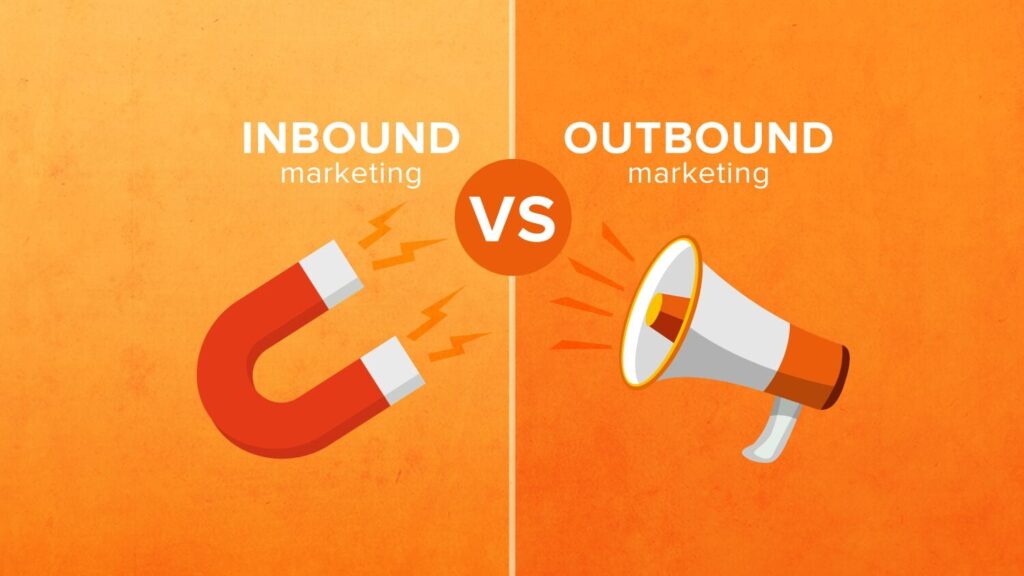As the CEO of a full-service marketing agency, I’m frequently asked about inbound and outbound marketing strategies and tactics. Which one should I use? Which one costs more? Which one will work best for my business?
While most people associate “inbound marketing” as a more current term and “outbound marketing” as a more traditional, they’ve both been around for centuries. The difference between marketing the last 10-15 years and previously is the inclusion of the internet and the digital channel opportunities marketing leaders must now navigate. (See our piece on “The Modern Marketing Director”)
What is Inbound Marketing?
At the core of inbound marketing is an effort for a business to produce thought leadership content of various types, all geared toward earning the attention of a prospective customer. Through various tactics and channels, such as SEO, SEM, social advertising, organic social reach and others, this content is distributed in hopes of intersecting with your target audience and ultimately providing them with value and a “solution” to address a “problem” they may be experiencing.
Take this article you are reading right now as an example. It is our hope that a) you are our target audience and b) this is providing you with incremental value, causing you to remember and possibly consider Workhorse Marketing for your needs. Perhaps you initially saw this article and the above fancy graphic on our social channels, shared from a colleague, via search engines or another way. Now that you’re reading the article and have shown interest, our goals are for you to click on our Request a Consultation CTA, thereby “converting” into a top-of-funnel prospect.
In theory, our only incremental costs to generate this lead are the time and expense to write this article, then post and optimize on our website, distribute through our channels and potentially back it with a small budget to boost exposure.
Inbound Marketing Works
While the above is a simple lead-gen example, we’ve helped many marketing leaders and businesses strategize and execute inbound marketing campaigns. We help them establish and boost lead-gen results over and over and over again. When done correctly, inbound marketing offers numerous benefits, such as:
– Helps increase SEO efforts, thereby attracting more attention
– Generates social media shares or inbound links
– Increases brand visibility
– Builds your brand equity in a thought leadership context
– Enables prospects to engage with your brand at their time of need
– Ultimately, generates qualified leads for less cost
I mentioned that inbound marketing has been going on for many years, much longer than the last 5-7 years we tend to discuss. People and businesses have been practicing the dissemination of “content” as a way to provide value and persuade an audience to take action for hundreds or thousands of years. Whether it be an expert advice article in a publication, white papers and case studies mailed to a target audience, or simply a flyer in a foyer, inbound marketing has proven effective for a long, long time.
What is Outbound Marketing?
Outbound marketing, often times called “interruption marketing”, is a more traditional form of pushing an advertisement in front of a target audience whether they have chosen to see it or not. TV and radio ads, pre-roll video, direct mail, trade shows, email blasts, banner and display ads, billboards, newspaper and magazine ads, cold calling, and contextual ads are all examples of outbound marketing.
This form of marketing is literally everywhere. On your next drive to or from work, look and listen — you’ll likely notice hundreds of outbound advertisements vying for your attention and action. And while marketing budgets continue to trend upward toward inbound strategies, outbound marketing strategies continue to dominate. As “digital” as we have become with creating strategies for our clients, outbound remains a very strong lead-gen approach.
Outbound Marketing Works
While many people commend the low CPL of inbound, you must always keep your eye on the quality of those leads and how they translate to your bottom-line CPA. I would argue that many outbound tactics, while more expensive (higher CPL), produce a far greater quality of lead at a later stage in the buyer’s journey, thereby ultimately leading to a stronger win rate and lower CPA. When you also consider the often hidden “waste” costs associated with low-quality leads, you can see why a strong, targeted outbound strategy can be highly effective.
Do What Works for Your Business
I’ve seen many articles suggest that outbound marketing is old or expensive and that you should solely move to inbound marketing. Admittedly, a few years back I drank a few gallons of the inbound marketing Kool-Aid. After reading the invigorating book Inbound Marketing: Attract, Engage, and Delight Customers Online, my belief toward the values of inbound marketing had strengthened to a high level.
However, if done properly, both outbound and inbound can work in unison, fully supporting each other. Strong outbound advertising or tradeshow efforts are fully supported by a strong thought leadership content strategy while your inbound traffic can be strengthened by a strong outbound brand presence.
Where Do You Go from Here?
In the end, you should do what works for your specific growth needs. If you have a very small and defined target audience (1,000 or less), you may find better results and a shortened sales cycle by focusing most of your efforts into outbound marketing. If you are a high transaction volume business, a long-term inbound marketing program will most likely produce cost-effective and successful results.
A combination of inbound and outbound marketing is important, not one or the other. You can have a great outbound marketing strategy, but if the content that you’re leading them to does not reflect the proper brand messaging, you’ll lose them quickly.
Workhorse Marketing exists to help marketing leaders and brands create strong branding, marketing, and advertising strategies. If you think we may be of use to your team, please feel free to reach out for a free consultation.

